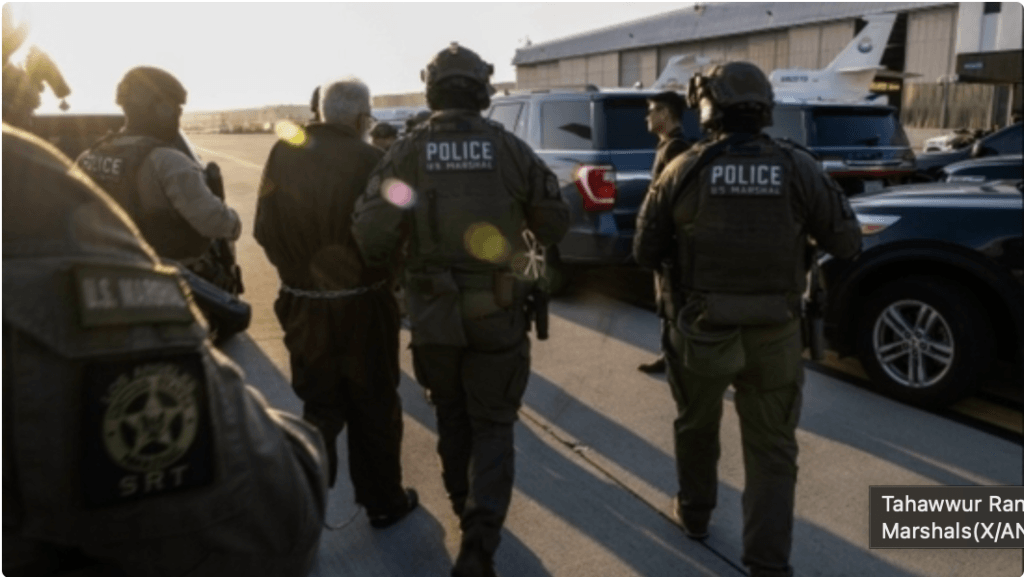Introduction
Exclusive photographs capturing the handover of Tahawwur Rana, a key suspect in the 2008 Mumbai terror attacks, to Indian authorities have surfaced, marking a pivotal moment in India’s decades-long pursuit of justice. The images, reportedly taken at Los Angeles International Airport (LAX), show Rana—a Pakistani-Canadian businessman—in custody, flanked by U.S. and Indian officials, reigniting global attention on one of India’s most high-profile extradition cases.

Breaking Down the Images
The leaked photos, shared anonymously on social media and verified by security sources, depict:
- Transfer Protocol: Rana, wearing a blue prison jumpsuit and handcuffs, escorted by U.S. Marshals to a private terminal.
- Indian Delegation: National Investigation Agency (NIA) officers and Ministry of External Affairs (MEA) representatives formally receiving custody.
- Documentation: Officials exchanging sealed folders, likely containing legal paperwork finalizing the extradition under the India-U.S. Mutual Legal Assistance Treaty (MLAT).
Background: Who Is Tahawwur Rana?
Rana, a Chicago-based immigration consultant, was convicted in 2011 by a U.S. court for providing material support to the Lashkar-e-Taiba (LeT), the Pakistan-based terror group behind the Mumbai attacks that killed 166 people, including six Americans. Key allegations:
- Role in 26/11: Facilitated communication between LeT operatives and David Headley, the plot’s key scout, via his immigration firm as cover.
- Evasion Tactics: Avoided extradition since 2020 by citing health risks and political asylum claims, overturned by a U.S. court in June 2023.
The Road to Extradition
- 2020 U.S. Court Order: Approved India’s request after confirming dual criminality (charges recognized in both nations).
- Legal Delays: Rana’s attorneys argued potential “political persecution” in India, dismissed due to sufficient evidence.
- Diplomatic Push: PM Modi’s 2023 U.S. visit reportedly accelerated the process, highlighting strengthened counterterrorism ties.
Reactions from Stakeholders
- Indian Government: “A historic step toward closure for victims’ families,” stated Home Minister Amit Shah.
- U.S. State Department: Reiterated commitment to “denying safe havens to terrorists.”
- Victims’ Kin: “Finally, accountability,” said Devika Rotawan, survivor of the Chhatrapati Shivaji Terminus attack.
Legal Implications and Next Steps
Rana faces charges under India’s Unlawful Activities Prevention Act (UAPA) and the Indian Penal Code (IPC). Key focus areas:
- Trial Timeline: Proceedings likely at Mumbai’s Special NIA Court, with witness testimonies from Headley (currently in U.S. custody).
- Geopolitical Impact: Potential strain on India-Canada relations, given Rana’s citizenship claims and Ottawa’s prior reluctance to cooperate.
Global Counterterrorism Significance
Rana’s extradition sets precedents:
- Reinforces India’s ability to leverage international treaties for terror suspects.
- Pressures Pakistan to act on India’s dossier of 35 fugitives, including Hafiz Saeed.
Conclusion
The visuals of Tahawwur Rana’s transfer symbolize a hard-won victory for India’s justice system, though challenges persist in securing convictions against cross-border terror networks. As the trial unfolds, it will test diplomatic alliances and set benchmarks for global counterterrorism collaboration.
Also read: India’s protracted fight to bring Tahawwur Rana back